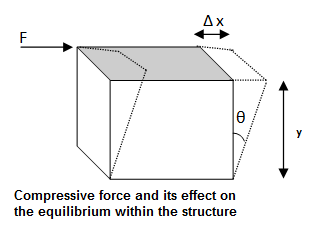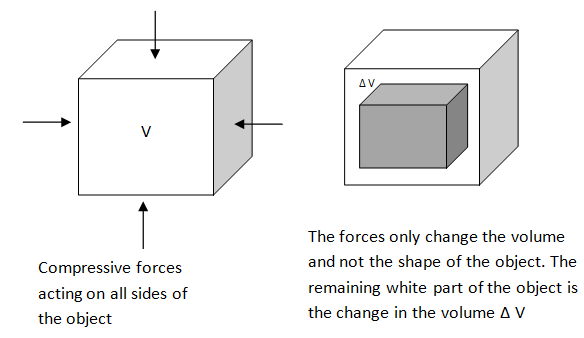Question 1: Explain the differences between tensile and compressive forces and how they affect equilibrium within a structure?
ANSWER
When an external force is applied on an object, it changes its shape or size. Hence there are three types of deformations and corresponding three elastic moduli.
- The tensile stress produces a tensile strain and their ratio is called Young’s Modulus. (Remember ‘tensile’ means ‘capable of being extended’, jo khaincha ja sakay and modulus means constant).
- Shear stress produces shear strain and the ratio is called shear modulus.(Shear here means to force sideways OR دباو کی وجہ سے کویی خرابی واقع ہونا).
- Bulk or volume stress produces volume strain and their ratio is called Bulk modulus. (Bulk means total volume).

(1) Tensile Force:
Consider a rod of length L and cross-sectional area A. If a force F is applied perpendicular to the cross-sectional area A, its length is increased by a length Δ L.
Now the ratio of the magnitude of the external force F to the area of cross-section A is called tensile stress. Therefore,

The ratio of the change in length, Δ L, to the original length, L, is called tensile strain.

Young’s Modulus is the ratio of tensile stress to the tensile strain.

Its unit is N m-2.
(2) Shear (or rigidity) Force

Consider the diagram in which a force is applied tangential to the surface of a block and the opposite side is held fixed.
Now the shear stress is the ratio of the deforming force F to the area A of the surface being sheared.

Shear strain is the ratio of the displacement of the sheared surface Δx and the fixed face y.

Now θ is called the angle of shear and is given by

For θ to be very small, tan θ = θ. Therefore,

Shear Modulus is the ratio of shear stress to the shear strain.
(3) Bulk Force
When the body is subjected to normal forces from all sides, its volume is decreased (deformed). Consider the diagram. The deformation of the objected occurs in its volume.

The ratio of the normal force F to the area A of the object is called Bulk or Volume stress.

The ratio of change in volume to the original volume is called volume strain.

Bulk modulus is the ratio of Bulk stress to Volume strain.

The negative sign shows increase in force causes a decrease in the volume.

Pingback:stress-strain-curve – msa
Pingback:Superconductivity – msa